The Importance of Leashes in Kitesurfing: Safety and More
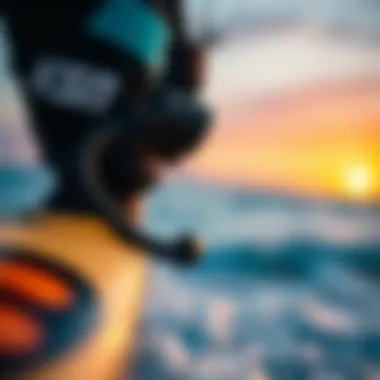
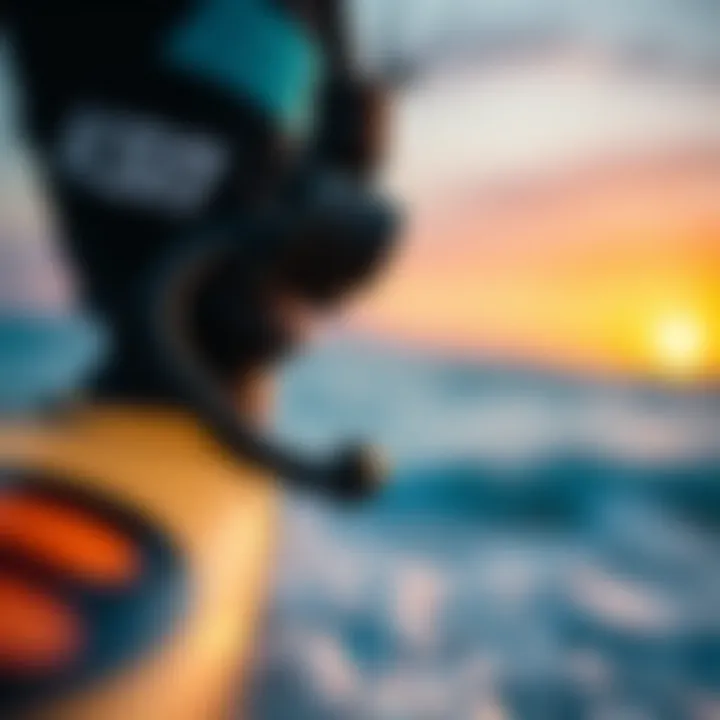
Intro
In the dynamic world of kitesurfing, a leash might seem like a minor accessory, but its importance cannot be overstated. This often-overlooked piece of equipment serves crucial functions in both safety and performance, impacting the rider’s experience in profound ways. While many enthusiasts may hit the water with excitement, a solid understanding of how leashes work and their variations can significantly enhance not just enjoyment but also safety on the water.
Kitesurfers navigate through waves with thrilling agility, but accidents can happen in the blink of an eye. This is where the leash plays a vital role. Today, we will dissect the different types of leashes, delve into techniques that optimize their usage, and explore advancements in leash technology that cater to the ever-evolving demands of kitesurfers. You’ll discover insights designed to serve everyone from beginners just dipping their toes into the sport to experienced riders refining their craft.
By the end of this article, we will have painted a complete picture of leash dynamics in kitesurfing, shedding light on how riders can leverage this sometimes-unseen element for optimal safety and performance. Let’s ride the wave of knowledge and dive into the first section.
Understanding Kitesurfing Equipment
Kitesurfing blends the thrill of surfing with the power of kites, attracting adrenaline junkies and water sports aficionados alike. At the core of this exciting activity lies a set of crucial equipment that ensures not just performance but also safety. Understanding this gear is a vital step for both beginners and seasoned riders; it’s the foundation upon which skills are built and experiences are enjoyed.
The Essential Components
To embark on kitesurfing, one needs more than just a kite and a board. The ensemble typically includes a harness and a leash, each serving distinct yet interconnected roles. The harness connects the rider to the kite, distributing the pull across the body and allowing for better control. As for the board, it needs the right balance of buoyancy and maneuverability. Each piece of equipment plays a part in creating a cohesive experience on the water, enabling riders to harness the wind's potential.
Advantages of Understanding Kitesurfing Equipment
- Enhanced Safety: Recognizing the nuances of each piece of gear, especially the leashes, can prevent accidents and enhance the rider's safety. For instance, knowing how to attach and manage the leash correctly could mean the difference between a thrilling ride and a troublesome situation.
- Improved Performance: Riders who grasp the functionalities of their gear can adjust their technique accordingly. Understanding how the harness interacts with the kite can provide greater control, leading to smoother and more impressive maneuvers.
- Informed Choices: The kitesurfing market is stuffed with options. Familiarity with equipment basics equips riders to make informed purchases, ensuring they select the right models for their skill level and pursuit.
In short, a solid grasp of kitesurfing equipment goes beyond mere technical knowledge. It cultivates a deeper appreciation for the sport and ensures a confident, informed approach, especially when venturing into more challenging conditions.
An Overview of Essential Gear
Kitesurfing gear comprises several pieces, including a kite, board, harness, and leash. Each element is specifically designed to contribute to the overall riding experience, and selecting the right equipment is paramount. Let's delve into some of these essentials:
- Kites: These come in different shapes and sizes, each designed for specific wind conditions and riding styles. It's essential to choose a kite that matches both the rider's weight and skill level.
- Boards: They vary in size and shape based on riding style, from freestyle to wave riding. A well-selected board provides better control and maneuverability.
- Harness: Integral for body support, harnesses come in waist and seat styles. The choice often depends on personal preference and the type of riding undertaken.
- Leash: This piece of equipment attaches to both the rider and the kite, preventing the kite from drifting away in case of a fall. The right leash enhances safety, which is paramount for all kitesurfers.
Having a comprehensive understanding of this equipment prepares riders for successful sessions on the water and elevates their overall experience.
Function and Importance of the Leash
The leash is a seemingly straightforward piece of equipment, yet its function and importance cannot be overstated. It serves as a critical safety measure, connecting the kite to the rider, and plays a vital role in maintaining control.
Why the Leash Matters
- Prevention of Kite Loss: When a rider wipes out, the last thing they want is their kite flying off uncontrollably. A leash ensures that the kite remains within reach, significantly reducing the risk of losing it to the waves or wind.
- Safety in Emergencies: If a kitesurfer finds themselves in a precarious position, the leash acts as a lifeline, allowing them to regain control more quickly and effectively.
- Impact on Performance: A well-designed leash can enhance maneuverability, which allows riders to perform various tricks and navigate more effectively through challenging conditions.
In essence, the leash is not merely an accessory. It is a lifeline that binds the rider to the kite, making it a cornerstone of kitesurfing safety and performance.
"A good leash is like a strong handshake. It sets the tone for all that follows."
The Design of Kitesurfing Leashes
The design of kitesurfing leashes plays a crucial role in enhancing the overall kitesurfing experience. It intertwines safety, functionality, and rider performance, solidifying its place as an integral component of any kitesurfing kit. Proper leash design can dictate the safety margins, allowing kiteboarders to push their limits without compromising on care. As we delve deeper into the components of kitesurfing leashes, it becomes clear that thoughtful design can make all the difference.
Materials Used in Manufacturing Leashes
When it comes to manufacturing leashes, the choice of materials is paramount. Various fabrics and components can significantly impact the durability and performance of these essential tools. Some common materials include:
- Nylon: This is a popular choice for leashes due to its strength and resistance to wear and tear.
- Neoprene: Often used for padding, neoprene adds comfort and flexibility to the leash.
- Polyester: Known for its resistance to UV rays, polyester is often used in leashes meant for prolonged exposure to sunlight.
- Polypropylene: As a lightweight material, polypropylene provides an efficient alternative that does not sacrifice strength.
Ultimately, choosing the right materials can enhance the lifespan of the leash, providing riders with peace of mind that their equipment is resilient against the elements.
Different Styles of Leashes
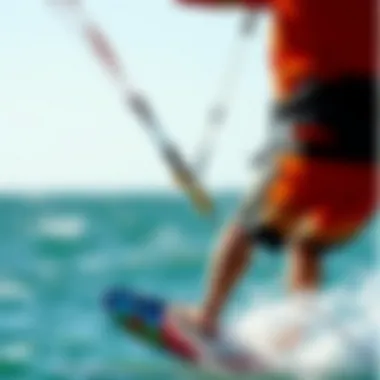
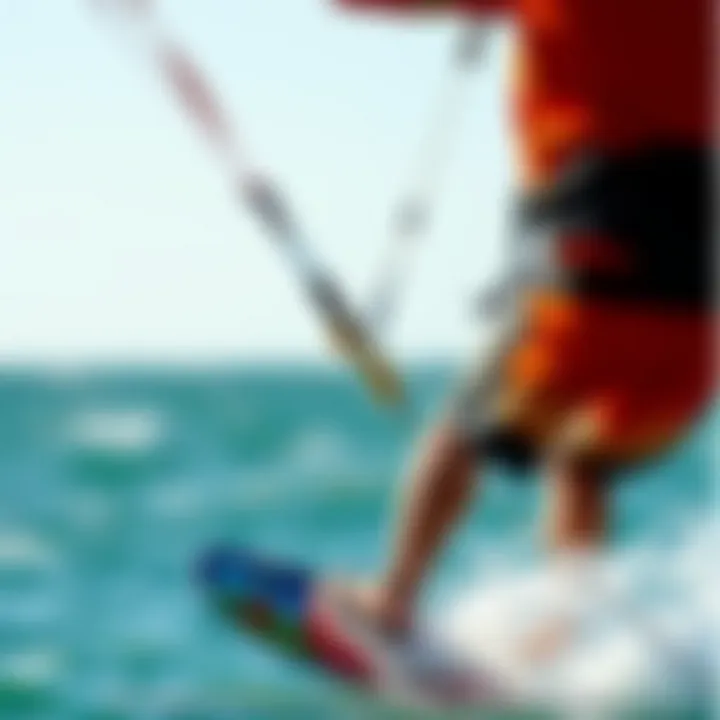
Not all leashes are created equal; they come in various styles that cater to different riding preferences and conditions. Here are a few notable designs:
- Standard Leash: The most common type, typically with a straight structure, ideal for general use.
- Coiled Leash: Designed to minimize drag in the water, coiled leashes are favored for their compactness and maneuverability.
- Adjustable Leash: This style allows riders to customize the length, granting adaptability based on conditions such as wind and waves.
- Surf Leash: Specifically tailored for surfing, these leashes may have additional features like a swivel to prevent tangling in waves.
Identifying which style suits one's riding technique can positively influence both performance and safety.
Advantages and Disadvantages of Each Type
Every style of leash carries its own set of advantages and disadvantages that kiteboarders should consider:
- Standard Leash:
Advantages: Simple to use, economical.
Disadvantages: Can create drag; may not be ideal for all wind conditions. - Coiled Leash:
Advantages: Reduces water drag, keeps the leash out of the way.
Disadvantages: Potential for tangles during rough conditions. - Adjustable Leash:
Advantages: Customizable length increases adaptability.
Disadvantages: Slightly heavier due to mechanisms, may not hold up in extreme wear. - Surf Leash:
Advantages: Enhanced flexibility, tangle-free design.
Disadvantages: Often less durable than standard designs, not as versatile.
Safety Considerations
When it comes to kitesurfing, safety consideration should never take a backseat. A leash is not just an accessory; it is a vital piece of kitesurfing equipment that plays a significant role in ensuring rider safety. Understanding the various aspects of leash usage can make all the difference between a thrilling experience and a potentially hazardous situation. In this section, we will delve into the risks associated with not using a leash, how leashes boost safety, and best practices to maximize peace of mind while riding.
Potential Risks of Not Using a Leash
Neglecting to use a leash while kitesurfing isn't just a minor oversight—it can lead to serious consequences. Picture this: you're out riding the waves, feeling the rush, and suddenly, the kite gets away from you. Without a leash, your kite can drift away, making it difficult if not impossible to recover it. This not only leads to athlete frustration but can also interfere with other kitesurfers in the area.
Moreover, if the kite goes rogue, it can create dangerous conditions not only for the rider but also for those around them. A loose kite can behave unpredictably, posing risks of collision or entanglement.
- Loss of equipment: Without a leash, you may lose your kite, resulting in high replacement costs.
- Hazard to others: Uncontrolled kites can pose an immediate threat to fellow kitesurfers, swimmers, or pedestrians.
In short, the absence of a leash elevates the potential for accidents significantly.
How Leashes Enhance Safety
Leashes are designed specifically to provide a direct connection between the rider and their kite. This simple yet effective tool serves numerous purposes:
- Control: A leash ensures that if you fall, the kite remains anchored and doesn’t take off like a wild stallion. This control allows for easier recovery, reducing the time spent worrying about lost equipment.
- Quick Release Features: Many modern leashes come equipped with safety mechanisms that facilitate quick detachment from the kite. This feature allows riders to disconnect swiftly in case of emergency, which can save lives.
"Using a leash is like having seat belts in a car; it greatly increases your safety on the road—or in this case, on the water."
- Increased Visibility and Awareness: When a kite remains tethered, even when downed, it provides a clearer picture for other surfers and beginners, mitigating the risk of accidents on crowded beaches.
Best Practices for Safe Use
Using a leash properly means more than just strapping it on. Here are some best practices to keep in mind:
- Regular Inspections: Before hitting the waves, routinely check your leash for wear and tear. Look out for fraying cords or weak points. If you find anything suspicious, it’s wise to replace the leash.
- Correct Fitting: Ensure that the leash is fitted properly to your harness or board. A loose or incorrectly attached leash can lead to accidental detachment.
- Stay Aware of Your Surroundings: Being mindful of other surfers and water users around you can prevent accidents. The winding nature of kites and lines means that entanglement can happen in the blink of an eye.
- Practice Quick Releases: Familiarize yourself with the quick-releasing mechanism of your leash. In an emergency scenario, knowing how to detach swiftly can make all the difference.
Implementing these practices can help ensure a safer kitesurfing experience for yourself and others, contributing to a more enjoyable time on the water.
Techniques for Effective Leash Use
Understanding how to utilize a leash effectively in kitesurfing goes beyond just attaching it to your board. Proper leash techniques are crucial for enhancing both safety and performance on the water. Without well-implemented leash use, kiteboarders can find themselves in precarious situations, such as losing control of their equipment or being in danger during wipeouts. The right techniques not only empower riders to maintain better control but also help in reducing the risk of accidents. Let's dive deeper into essential methods and practices.
Proper Attachment Methods
When it comes to attaching the leash, the approach might seem straightforward, yet small errors can lead to significant consequences. A common method is to secure the leash on the heel of the back foot. This positioning allows for quick release during emergencies, but it’s crucial to ensure the release mechanism is working smoothly. In contrast, some opt to attach the leash to the board’s handle. This method can offer a more stable connection but might not provide that swift escape in critical moments.
- Consider the following methods:
- Key Considerations:
- Heel Attachment: Ideal for new and experienced riders alike. Ensure it’s snug but not overly tight.
- Board Handle Attachment: Great for experienced riders who’ve mastered their control while riding.


- Always test your attachment before hitting the waves.
- Be aware of the potential for tangling; avoid excessive slack in the leash line.
In summary, knowing how to properly attach the leash is vital for enhancing your safety and enabling quick maneuvers when needed. Mistakes made here can escalate quickly, so practice attaching the leash before your ride.
Managing the Leash in Different Conditions
Kitesurfing conditions can change rapidly. The way you manage your leash can significantly affect how you react to shifts in the wind, water, and even your riding skills. In light wind, a longer leash may be favorable, providing more freedom with kite movements. On the other hand, high winds call for a shorter leash to keep your control taut, minimizing the chances of snags or entanglements.
Key Strategies
- Light Wind Conditions:
- Strong Wind Conditions:
- Use a leash with some slack, allowing kite movement without pulling you excessively. Avoid overly complicated maneuvers that increase the chance of getting tangled.
- A shorter leash is your best ally. This helps control the board’s movement and decreases the chances of the kite power pulling you unexpectedly.
Additionally, always keep in mind the type of terrain or environment you are navigating. Riding close to rocky areas or through surf zones requires agile leash management as well.
Training Techniques to Master Leash Management
Training is a critical piece of becoming comfortable with your leash. Whether you’re an instructor or an aspiring professional, honing leash management skills should be at the forefront of your practice sessions.
- Drills to Enhance Your Skills:
- Seek Guidance:
- Repetition Drills: Practice attaching and detaching the leash while on the beach to build muscle memory.
- Mock Emergencies: Simulate falling and practice quick release and retrieval of your board.
- Enlist a fellow kitesurfer or instructor to critique your leash management techniques. Getting feedback can be among the most effective methods to improve your skills.
Training is not just about perfecting techniques; it’s also about gaining confidence on the water. Feeling at ease with your leash means you can focus better on riding than on worries about the gear.
Mastering leash use in these various scenarios solidifies the foundation of any kiteboarder's skill set. Whether you're experiencing the thrill of a competition or catching waves with friends, effective leash management can make all the difference.
Innovations in Leash Technology
Kitesurfing isn’t just about the wind and waves; it's also the tools and gear we're using. The leash plays a critical role in not only the safety of the rider but also impacts the overall kitesurfing experience. With technology continuously evolving, innovations in leash design and functionality have taken center stage. These advancements are shaping how kiteboarders interact with their gear and improve performance while ensuring safety.
Emerging Materials and Designs
Gone are the days when leashes were primarily made from generic nylon. Today, manufacturers are experimenting with a range of high-performance materials that can withstand the rigors of saltwater, UV exposure, and physical wear.
- Dyneema: This material is known for its exceptional strength-to-weight ratio. It’s lightweight yet extremely durable, making it a popular choice for many kitesurfers. The washed-out, tattered look of a leash is now a thing of the past, thanks to Dyneema's ability to maintain integrity over time.
- Neoprene Padding: The incorporation of neoprene in leash designs offers comfort and prevents chafing against the skin. Riders can maneuver more freely, focusing on their technique rather than managing discomfort caused by rigid straps.
- Flexibility and Elasticity: Newer leash designs also put emphasis on flexibility, allowing for a natural range of motion. This is especially significant during jumps or tricks, where being tethered yet mobile is essential.
Moreover, innovative designs are beginning to bubble to the surface. We see leashes that come equipped with quick-release mechanisms. This can be a game-changer in emergency situations, allowing riders to disconnect from their board or kite swiftly.
Smart Leashes and Technology Integration
As the kitesurfing world wakes up to technology’s possibilities, the emergence of smart leashes marks an exciting leap forward. These leashes are not just utilitarian but can now be equipped with gadgets that offer real-time data and enhance user experience.
- GPS Tracking: Some modern leashes now integrate GPS technology. This means a rider can track their movements on the water, giving valuable insights into performance metrics. Knowing your top speed or distance covered can aid in progression and skill development.
- Impact Monitoring: Advanced leashes can even monitor sudden jarring movements, helping in understanding whether a rider is taking on too much risk while attempting new tricks. This feedback empowers kiteboarders to make more informed decisions.
- Phone Integration: Imagine being able to receive notifications or alerts right from your leash. It's a growing trend to have leashes that sync with smartphones, allowing riders to stay connected without interruption while out on the water.
"In kitesurfing, every little factor can make or break the ride. Innovations in leash technology are not just trends; they are essentials for the future."
These innovations are ushering in a wave of sophistication and efficiency, ensuring that kitesurfers stay not just safer but also smarter in their craft. The thoughtful integration of these technologies certainly provides kite enthusiasts with a more engaging and productive experience on the water. As the sport continues to evolve, so too will the tools that enhance it.
Environmental Considerations in Leash Production
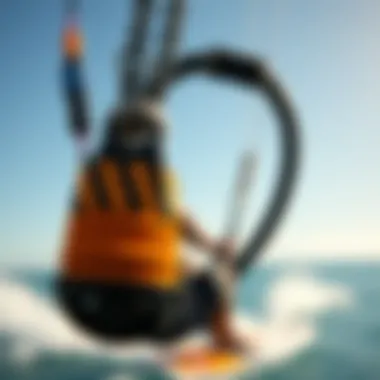
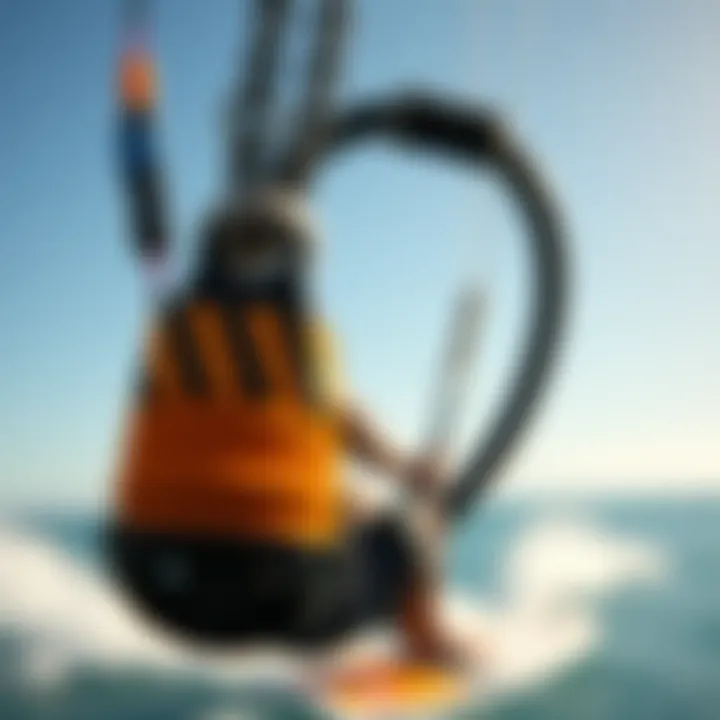
In today's world, environmental concerns play a significant role in many industries, and kitesurfing is no exception. As kiteboarding continues to grow in popularity, so does the production of equipment, particularly leashes. With this increase, it becomes crucial to examine how leashes are crafted and the implications of their materials on the environment. This section dives into the pressing issues surrounding the sustainability of leash construction and the impact of waste on our oceans.
Sustainable Materials in Leash Construction
When talking about the creation of kitesurfing leashes, it's important to highlight the materials used. Traditionally, many leashes have relied on plastic and synthetic fabrics, which are often derived from fossil fuels. While these materials might offer durability and flexibility, they lead to environmental degradation through extraction processes and long-term waste issues.
However, innovation in this field is spurring a transition to more sustainable alternatives. Manufacturers are exploring materials like recycled PET, which is derived from used plastic bottles, and other bio-based composites that possess similar qualities to their non-sustainable counterparts but with a lower ecological footprint.
Some key considerations when selecting sustainable materials include:
- Durability: Ensuring that the leash can withstand the rigors of kitesurfing while being environmentally friendly.
- Accessibility: The availability of sustainable materials can influence widespread adoption in the industry.
- Cost-effectiveness: For sustainable materials to gain traction, they need to be competitively priced to meet market demands.
By integrating these sustainable materials into leash construction, manufacturers can reduce the environmental impact significantly while maintaining performance standards.
Impact of Leash Waste on Marine Ecosystems
The issue of waste is not merely about the production of kitesurfing leashes; it extends to how they are disposed of after their usefulness has worn out. Unfortunately, many riders may not think twice before tossing an old leash away, contributing to the growing problem of marine pollution. The world’s oceans already face significant challenges, from plastic bags to fishing gear, so kitesurfing leashes can further exacerbate these concerns if not properly managed.
Studies have indicated that plastic debris can harm marine wildlife, often entangling or being ingested by creatures, affecting the delicate balance of marine ecosystems. It’s more than just a visual problem; it can personify a threat to entire species. To prevent this,
- Introduce recycling programs: Encourage riders to return their old leashes to manufacturers or participating shops for proper recycling.
- Educate the community: Increasing awareness among kiteboarders about the ecological impact of their equipment can lead to more responsible behavior.
- Design for disassembly: Future leash designs should consider the end-of-life stage, allowing for easier recycling.
In essence, minimizing leash waste and promoting sustainable practices is pivotal in protecting our oceans. The kitesurfing community must work as a collective to ensure that while we enjoy the winds and waves, we also keep our marine environments safe.
Community Perspectives on Leash Use
Understanding how experienced kiteboarders and competitive riders view leashes can provide invaluable insights into their importance in the sport. Community perspectives are not uniform; they vary greatly based on personal experiences, skill levels, and the specific contexts in which kitesurfing is practiced. This section seeks to highlight those differences, showcasing the benefits and considerations related to leash use.
Experiences from Seasoned Kiteboarders
When it comes to kitesurfing, seasoned kiteboarders often have rich stories to share about the role of the leash. Many of them have encountered situations where a leash made all the difference, whether in terms of safety, performance, or technique.
For example, John, an avid kitesurfer from Florida, recalls an instance where his leash saved him from losing his board in turbulent waters during a storm. He emphasizes that in the heat of the moment, having that connection made it much easier to retrieve his board quickly, thus preventing further complications.
Another essential point raised by the community is the evolution of leash technology and how it has affected overall kiteboarding experiences. Many seasoned kiteboarders believe that improved materials and designs have led to increased safety. They appreciate leashes that can quickly release under stress while also maintaining a strong connection during regular riding conditions. This balance helps riders feel secure but still complete maneuvers efficiently.
Moreover, seasoned kiteboarders often share tips on leash care and maintenance. Regular checks for wear and tear can mean the difference between safety and potential danger. A little time spent maintaining gear can go a long way in ensuring those exhilarating days on the water remain enjoyable.
Leashes in Competitive Kitesurfing
The narrative around leashes shifts notably within competitive kitesurfing. Participants in the sport view leashes as a necessary yet debated component during contests. While many recognize the importance of a leash for safety, they also argue that it can impede certain aerial tricks. Competitors like Lisa from California note that in high-stakes events, the risk of getting the leash tangled can sometimes outweigh its benefits.
- Performance Trade-offs: Many athletes weigh the pros and cons of leash use. Some vigorously argue for no leash during competitions to enhance freedom of movement, suggesting that a loose board can be used strategically during jumps, tricks, and landings.
- Safety Considerations: On the flip side, many competitors believe that the advantages of having a leash outweigh the performance downsides. When competing at high speeds and technical maneuvers, the ability to instantly regain board control is a significant advantage, especially in crowded waters.
Leagues and events sometimes have specific rules regarding leash use, further complicating things. Newcomers to competitive kitesurfing often report uncertainty about when a leash is essential or beneficial. Engaging with seasoned professionals in the community can provide clarity and truly highlight the nuances of leash usage based on competitive contexts.
"A leash is like your kite’s best friend. It’s meant to keep you connected, but you don’t want it dragging you down during the exciting moments!"
The voices threading through this community reveal the myriad ways kitesurfers of all levels regard leashes, ultimately crafting a culture that emphasizes both safety and performance.
For more insights and a continuation of these conversations, consider visiting online forums like Reddit, where kiteboarding enthusiasts discuss their experiences and tips.
Closure: Enhancing Performance and Safety
In the realm of kitesurfing, the leash often doesn't get the limelight it deserves, yet its significance cannot be overstated. It serves as a vital lifeline not just enhancing safety, but also elevating the overall riding experience. An effective leash can mean the difference between a thrilling ride and a dangerous situation. Its function goes beyond merely keeping the rider connected to the kite; it encapsulates a variety of safety features and technical benefits that collectively foster a much more enjoyable outing on the water.
From the basic safety aspect of preventing gear loss to the performance enhancements it brings during various riding conditions, the leash holds intrinsic value. For instance, using a leash allows riders to confidently maneuver through waves and gusts without the constant worry of their kite flying away. This leash connection offers a sense of security that empowers them to explore new tricks and techniques, pushing the limits of their skill set without fear.
"The leash isn’t just a tool, it’s an extension of the rider's intent and mastery over kitesurfing."
When riders and instructors talk about best practices, it's essential to highlight that a well-maintained, properly attached leash is crucial to optimizing that experience. Choosing a leash designed from the right materials and learning how to manage it effectively in variable conditions are equally pertinent considerations. All these factors work in tandem, creating a symbiotic relationship between safety and performance that allows enthusiasts to fully appreciate the fervor of kitesurfing, while mitigating risks.
Moreover, the evolution of leash technology reflects an ongoing commitment to rider safety and comfort. Innovators in the industry are constantly working on improving designs, utilizing sustainable materials, and integrating advanced features into leashes. These innovations not only charm the eco-conscious but also signify a progressive advancement in kitesurfing as a whole.







